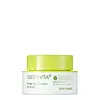What's inside
What's inside
 Key Ingredients
Key Ingredients

 Benefits
Benefits

 Concerns
Concerns

 Ingredients Side-by-side
Ingredients Side-by-side

Xylitol
HumectantMelia Azadirachta Leaf Extract
Skin ConditioningVitex Agnus-Castus Extract
AstringentChamomilla Recutita Flower Extract
MaskingMelia Azadirachta Flower Extract
Skin ConditioningGlucose
HumectantSodium Hyaluronate
HumectantCitrus Unshiu Peel Extract
MaskingArctium Lappa Root Extract
Skin ConditioningPhellinus Linteus Extract
Skin ConditioningCurcuma Longa Root Extract
MaskingOcimum Sanctum Leaf Extract
Skin ConditioningCorallina Officinalis Extract
Skin ConditioningPolyglyceryl-10 Laurate
Skin ConditioningPolyglyceryl-3 Polydimethylsiloxyethyl Dimethicone
Skin ConditioningTrisiloxane
Skin ConditioningDimethiconol
EmollientOctyldodeceth-16
EmulsifyingPolyglyceryl-10 Myristate
Skin ConditioningPEG-240/Hdi Copolymer Bis-Decyltetradeceth-20 Ether
StabilisingAmmonium Acryloyldimethyltaurate/Vp Copolymer
Carbomer
Emulsion StabilisingArginine
MaskingTromethamine
BufferingDisodium EDTA
Biosaccharide Gum-1
HumectantHydroxypropyltrimonium Hyaluronate
Hydrolyzed Hyaluronic Acid
HumectantSodium Acetylated Hyaluronate
HumectantHyaluronic Acid
HumectantSodium Hyaluronate Crosspolymer
HumectantPotassium Hyaluronate
Skin Conditioning3-O-Ethyl Ascorbic Acid
Skin ConditioningEthylhexylglycerin
Skin ConditioningCitrus Aurantium Dulcis Peel Oil
MaskingOlea Europaea Fruit Oil
MaskingCitrus Aurantium Bergamia Fruit Oil
MaskingCopaifera Officinalis Resin
MaskingCymbopogon Martini Oil
MaskingPelargonium Graveolens Flower Oil
MaskingCitrus Nobilis Peel Oil
MaskingSalvia Sclarea Oil
MaskingXylitol, Melia Azadirachta Leaf Extract, Vitex Agnus-Castus Extract, Chamomilla Recutita Flower Extract, Melia Azadirachta Flower Extract, Glucose, Sodium Hyaluronate, Citrus Unshiu Peel Extract, Arctium Lappa Root Extract, Phellinus Linteus Extract, Curcuma Longa Root Extract, Ocimum Sanctum Leaf Extract, Corallina Officinalis Extract, Polyglyceryl-10 Laurate, Polyglyceryl-3 Polydimethylsiloxyethyl Dimethicone, Trisiloxane, Dimethiconol, Octyldodeceth-16, Polyglyceryl-10 Myristate, PEG-240/Hdi Copolymer Bis-Decyltetradeceth-20 Ether, Ammonium Acryloyldimethyltaurate/Vp Copolymer, Carbomer, Arginine, Tromethamine, Disodium EDTA, Biosaccharide Gum-1, Hydroxypropyltrimonium Hyaluronate, Hydrolyzed Hyaluronic Acid, Sodium Acetylated Hyaluronate, Hyaluronic Acid, Sodium Hyaluronate Crosspolymer, Potassium Hyaluronate, 3-O-Ethyl Ascorbic Acid, Ethylhexylglycerin, Citrus Aurantium Dulcis Peel Oil, Olea Europaea Fruit Oil, Citrus Aurantium Bergamia Fruit Oil, Copaifera Officinalis Resin, Cymbopogon Martini Oil, Pelargonium Graveolens Flower Oil, Citrus Nobilis Peel Oil, Salvia Sclarea Oil
Water
Skin ConditioningGlycerin
HumectantPalmitic Acid
EmollientLauric Acid
CleansingStearic Acid
CleansingPEG-32
HumectantPotassium Hydroxide
BufferingMyristic Acid
CleansingButylene Glycol
HumectantGlyceryl Stearate
EmollientCocamidopropyl Betaine
CleansingTea-Lauryl Sulfate
CleansingPEG-100 Stearate
Snail Secretion Filtrate
Skin ConditioningPotassium Cocoyl Glycinate
Sodium Chloride
MaskingCitrus Limon Peel Oil
MaskingPhenoxyethanol
PreservativeChlorphenesin
AntimicrobialArachidic Acid
CleansingCoptis Japonica Root Extract
Skin ConditioningEthylhexylglycerin
Skin ConditioningCaprylyl Glycol
EmollientChamaecyparis Obtusa Water
MaskingCapric Acid
CleansingCitrus Aurantium Bergamia Fruit Oil
MaskingDisodium EDTA
Polyquaternium-7
Citrus Aurantium Dulcis Peel Oil
MaskingImperata Cylindrica Root Extract
Skin ConditioningOpuntia Ficus-Indica Extract
Skin ConditioningPinus Sylvestris Leaf Oil
MaskingCitrus Aurantifolia Oil
CleansingAcrylamidopropyltrimonium Chloride/Acrylamide Copolymer
Propanediol
SolventEucalyptus Globulus Leaf Oil
PerfumingPEG-8
HumectantCarbomer
Emulsion StabilisingCentella Asiatica Extract
CleansingMagnesium Nitrate
Carica Papaya Fruit Extract
Skin ConditioningAloe Barbadensis Leaf Juice
Skin ConditioningBeta-Glucan
Skin ConditioningPotassium Sorbate
PreservativeSodium Benzoate
MaskingMethylchloroisothiazolinone
PreservativeMagnesium Chloride
Methylisothiazolinone
PreservativeWater, Glycerin, Palmitic Acid, Lauric Acid, Stearic Acid, PEG-32, Potassium Hydroxide, Myristic Acid, Butylene Glycol, Glyceryl Stearate, Cocamidopropyl Betaine, Tea-Lauryl Sulfate, PEG-100 Stearate, Snail Secretion Filtrate, Potassium Cocoyl Glycinate, Sodium Chloride, Citrus Limon Peel Oil, Phenoxyethanol, Chlorphenesin, Arachidic Acid, Coptis Japonica Root Extract, Ethylhexylglycerin, Caprylyl Glycol, Chamaecyparis Obtusa Water, Capric Acid, Citrus Aurantium Bergamia Fruit Oil, Disodium EDTA, Polyquaternium-7, Citrus Aurantium Dulcis Peel Oil, Imperata Cylindrica Root Extract, Opuntia Ficus-Indica Extract, Pinus Sylvestris Leaf Oil, Citrus Aurantifolia Oil, Acrylamidopropyltrimonium Chloride/Acrylamide Copolymer, Propanediol, Eucalyptus Globulus Leaf Oil, PEG-8, Carbomer, Centella Asiatica Extract, Magnesium Nitrate, Carica Papaya Fruit Extract, Aloe Barbadensis Leaf Juice, Beta-Glucan, Potassium Sorbate, Sodium Benzoate, Methylchloroisothiazolinone, Magnesium Chloride, Methylisothiazolinone
Ingredients Explained
These ingredients are found in both products.
Ingredients higher up in an ingredient list are typically present in a larger amount.
Carbomer is a polymer of acrylic acid. Its main role is to create a gel consistency.
A high amount of carbomer can cause pilling or balling up of products. Don't worry, most products contain 1% or less of carbomer.
Citrus Aurantium Bergamia Fruit Oil is the oil from the bergamot orange. It is native to Italy.
This ingredient is used to add fragrance to products. It contains limonene, linalool, and linalyl acetate.
The term 'fragrance' is not regulated in many countries. In many cases, it is up to the brand to define this term. For instance, many brands choose to label themselves as "fragrance-free" because they are not using synthetic fragrances. However, their products may still contain ingredients such as essential oils that are considered a fragrance.
When used topically, Citrus Aurantium Bergamia Fruit Oil is a photosensitizer due to its furanocoumarins. Photosensitizers make the skin and eyes much more sensitive to sunlight. Photosensitizers are linked to skin cancer.
However, more cosmetics using Citrus Aurantium Bergamia Fruit Oil are removing the furanocoumarins.
Bergamot oil was also found to have anti-inflammatory, antibacterial and antifungal properties.
Learn more about Citrus Aurantium Bergamia Fruit OilCitrus Aurantium Dulcis Peel Oil is oil from the peel of an orange fruit.
Limonene and linalool make up the majority of oils from citrus peels. Limonene has a "citrus" fragrance. Citrus peels also contain flavonoids, which have anti-inflammatory properties.
Citrus peel is also a rich source of flavonoids. Flavonoids are natural antioxidants and help protect your skin against damage. Flavonoids are a group of compounds naturally found in vegetables and fruits.
The term 'fragrance' is not regulated in many countries. In many cases, it is up to the brand to define this term. For instance, many brands choose to label themselves as "fragrance-free" because they are not using synthetic fragrances. However, their products may still contain ingredients such as essential oils that are considered a fragrance.
Learn more about Citrus Aurantium Dulcis Peel OilDisodium EDTA plays a role in making products more stable by aiding other preservatives.
It is a chelating agent, meaning it neutralizes metal ions that may be found in a product.
Disodium EDTA is a salt of edetic acid and is found to be safe in cosmetic ingredients.
Learn more about Disodium EDTAEthylhexylglycerin (we can't pronounce this either) is commonly used as a preservative and skin softener. It is derived from glyceryl.
You might see Ethylhexylglycerin often paired with other preservatives such as phenoxyethanol. Ethylhexylglycerin has been found to increase the effectiveness of these other preservatives.